Ultimate Delphi, Greece Travel Guide: The Perfect Day Trip From Athens
Nestled on the slopes of Mount Parnassus, Delphi was considered the center of the ancient Greek world, a place where people from across the Mediterranean would gather to seek the wisdom and guidance of the Oracle. The site is steeped in mythology, history, and a sense of spiritual mysticism that has endured for millennia.
In my ultimate Delphi, Greece guide, I’ll be sharing everything you need to know about visiting from the best time to visit to how to get here, tips for visiting, what to wear, and more.
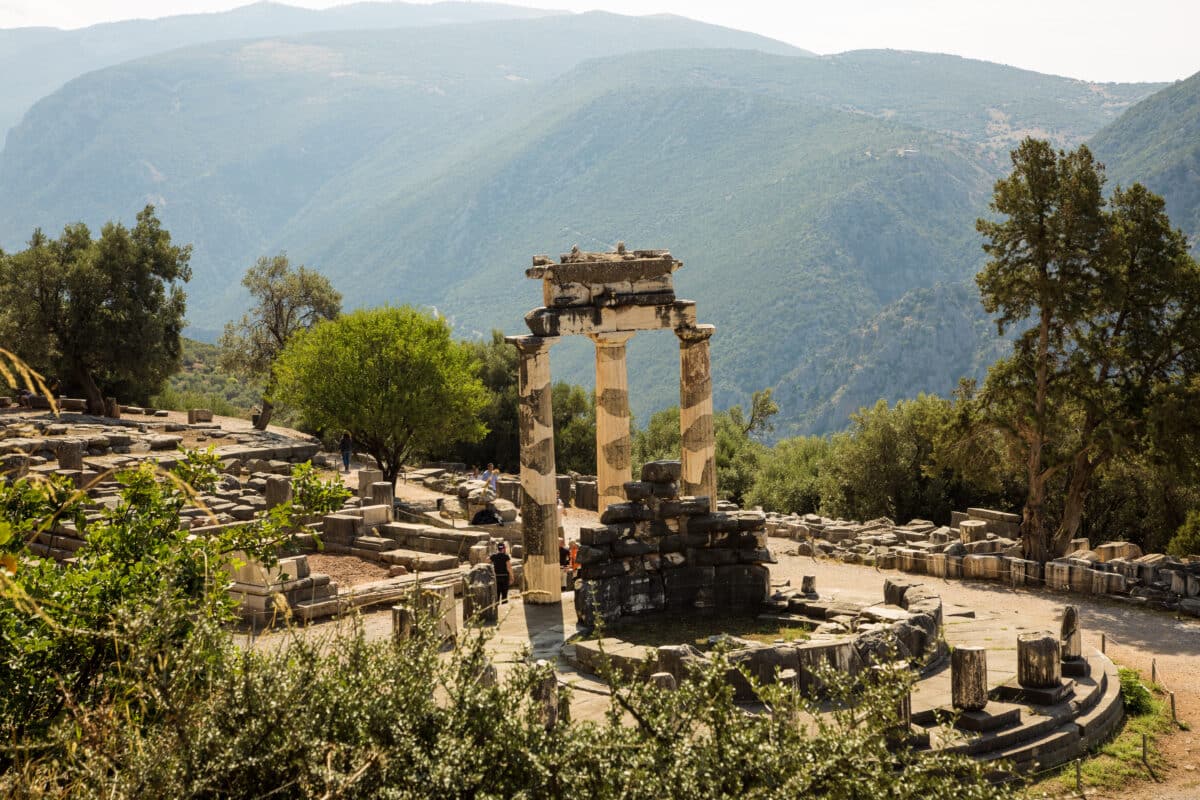
My Delphi, Greece YouTube Video:
*Disclosure: some of these links are affiliate links. Meaning, if you click a link and make a purchase, Have Clothes, Will Travel gets a very small commission at no extra cost to you. Thank you for supporting the brands that make this blog possible!
Quick History of Delphi
Delphi was an ancient religious sanctuary dedicated to the Greek god Apollo. Developed in the 8th century B.C., the sanctuary was home to the Oracle of Delphi and the priestess Pythia, who was famous throughout the ancient world for seeing the future and was consulted before all major undertakings.
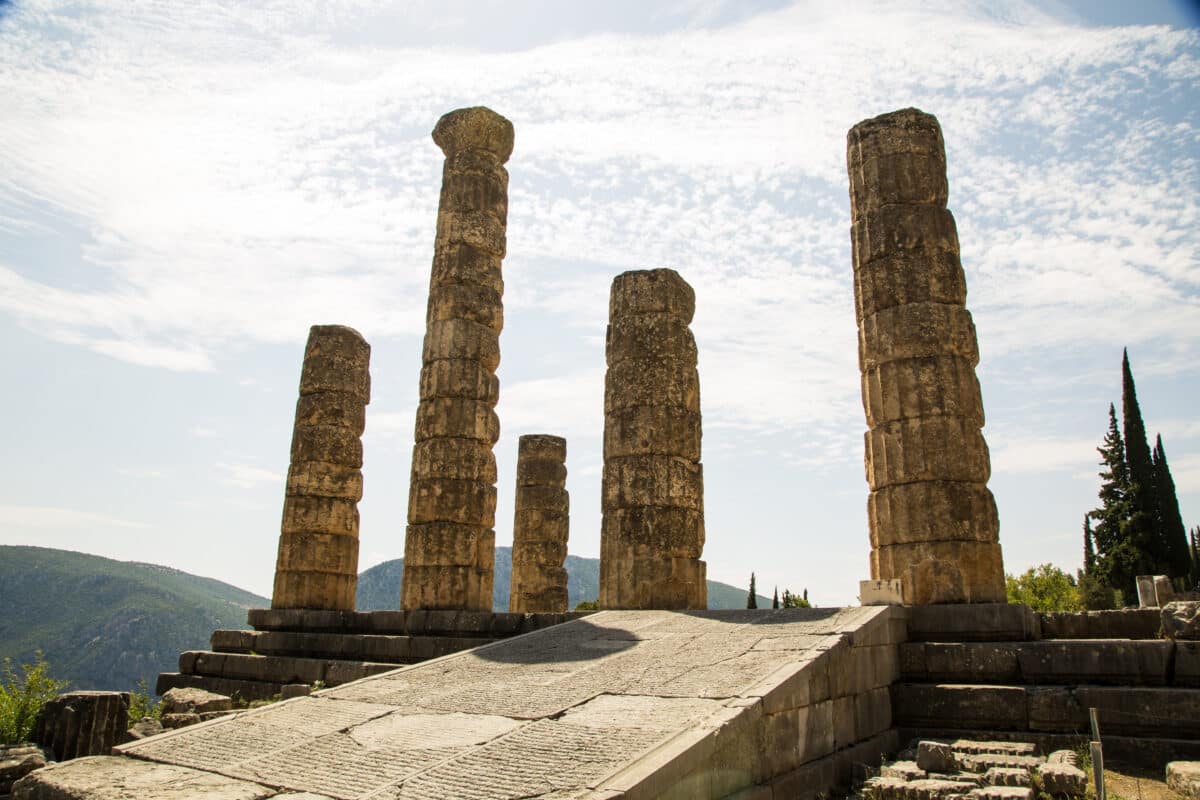
Where is Delphi? And How Do You Get There From Athens?
Delphi is about 185 kilometers northwest of Athens. Getting to Delphi from Athens is pretty straightforward.
The most convenient way to get here is to rent a car and drive the 2-and-a-half-hour route on the E75 highway. Then, you can explore Delphi at a leisurely pace. Just be aware that there is no designated parking area at Delphi. You’ll have to park along side the road and walk. You CANNOT park by the museum entrance.
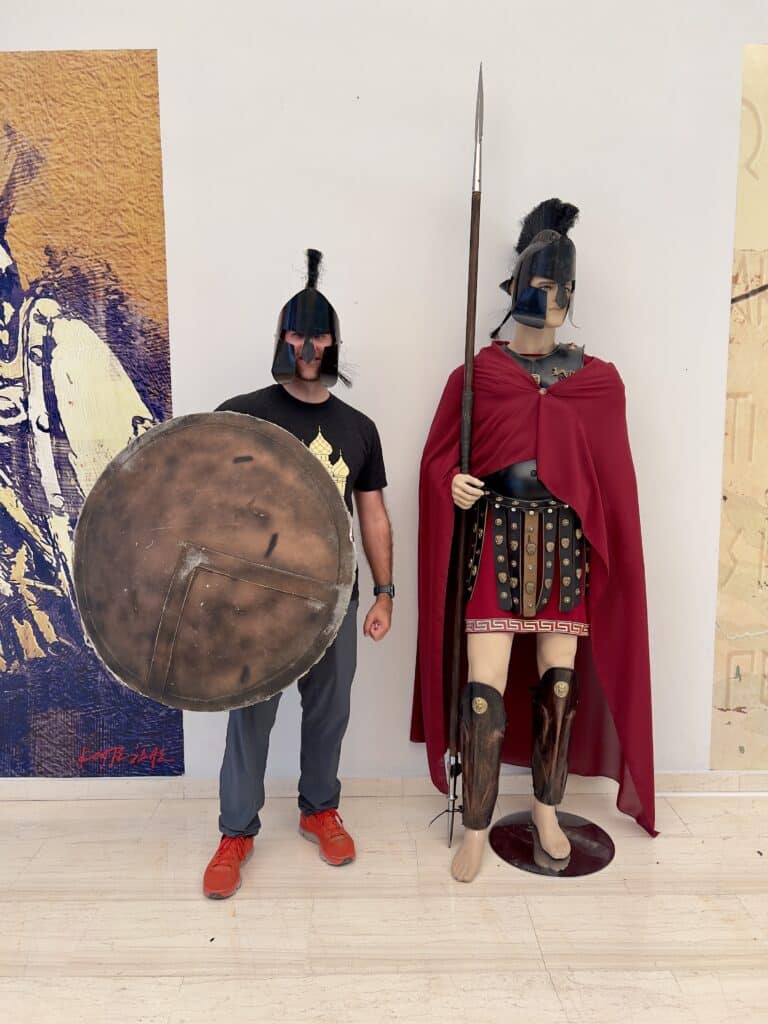
If you’re driving yourself, you can also make a pitstop along the way in Thermopylae and see the Battle of Thermopylae museum and grave site. This is where the battle of the 300 Spartans against the Persian army happened, and the 300 Spartan soldiers are said to be buried.
Another option it to take a bus from Athens’ central bus station. The bus ride takes about 2 and a half hours to 3 hours and is a more budget-friendly option, but of course doesn’t offer the same flexibility.
There are also organized tours that leave from Athens and include transportation, entrance fees, and a local guide. This is by far the easiest way to get to Delphi from Athens.
Lastly, you can hire a private driver to take you from Athens to Delphi. This is personally what I did and I loved it. It is, however, the most expensive way to go about this. But it sure was nice to have the freedom of a car without the hassle of driving or trying to find a parking spot along the road.
Sakis was the name of my driver through PGT, and he was amazing!
Side note: Many of these tours also offer the option to combine Delphi with Meteora for a multi-day trip. I visited both sites and highly recommend visiting Meteora if your schedule allows it. However, if you only have time for a day tour, Delphi is much easier to do as a day trip from Athens than Meteora. If you are combining Delphi and Meteora, it is better to plan at least two days for this.
Exploring Delphi: Must-See Attractions and Landmarks
Now, a quick overview of what you can expect to see when you visit Delphi. The main archaeological site is divided into several key areas, each offering a unique glimpse into the past.

1.) The sanctuary of Athena Pronaia, which means “the one before” the temple of Apollo. This was the first temple visited by visitors who came to Delphi on foot from the eastern road; hence, its name.

2.) The Sacred Way: This was the main route used by pilgrims and visitors to access the sanctuary of Delphi. As you walk along the Sacred Way, you’ll encounter numerous monuments, treasuries, and statues that were dedicated to the gods.
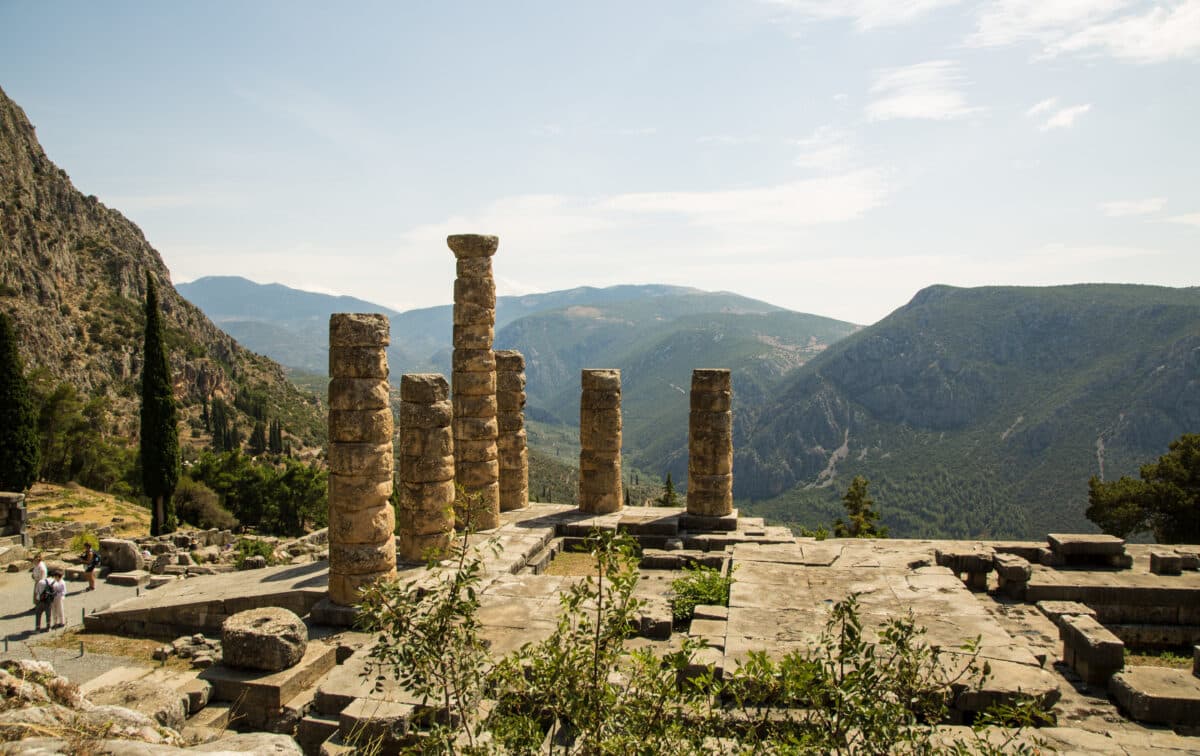
3.) The Temple of Apollo: At the heart of Delphi stands the impressive ruins of the Temple of Apollo, where the Oracle of Delphi would deliver her visionary pronouncements.
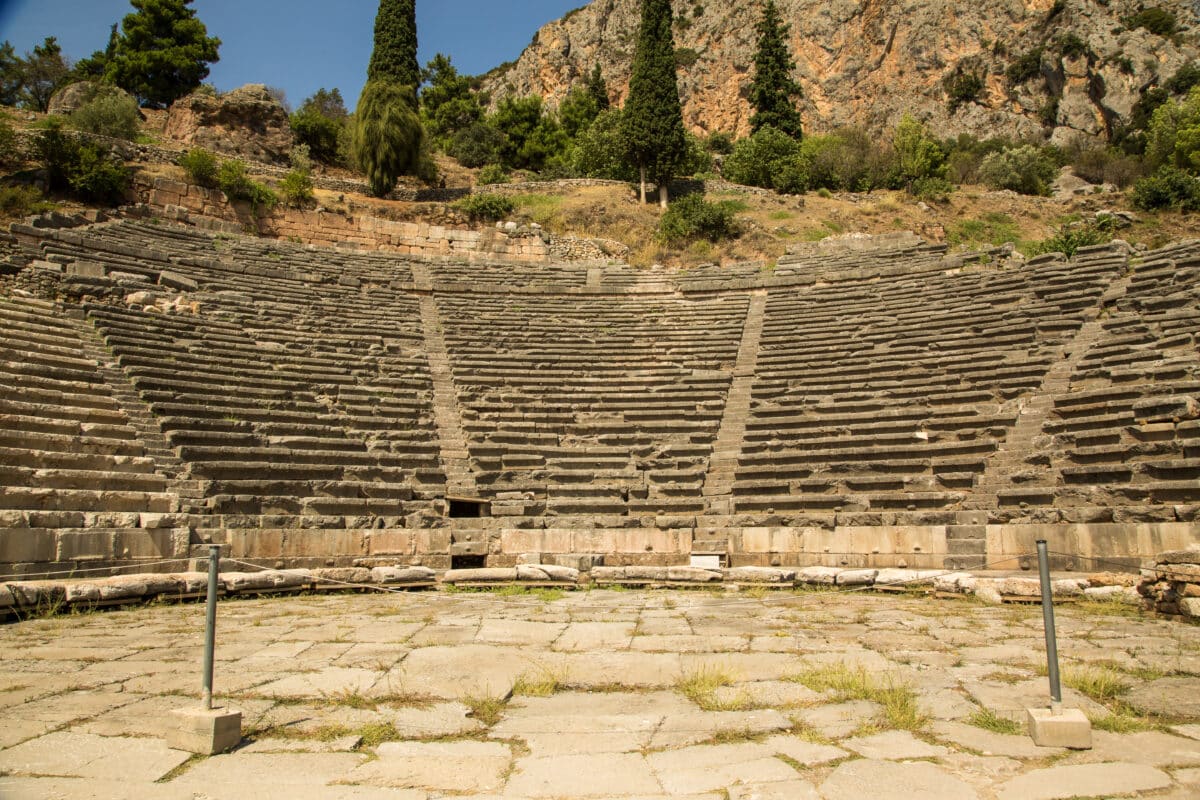
4.) The Theatre: Delphi’s ancient theatre was the site of dramatic performances and cultural events that were integral to the sanctuary’s rituals and celebrations.
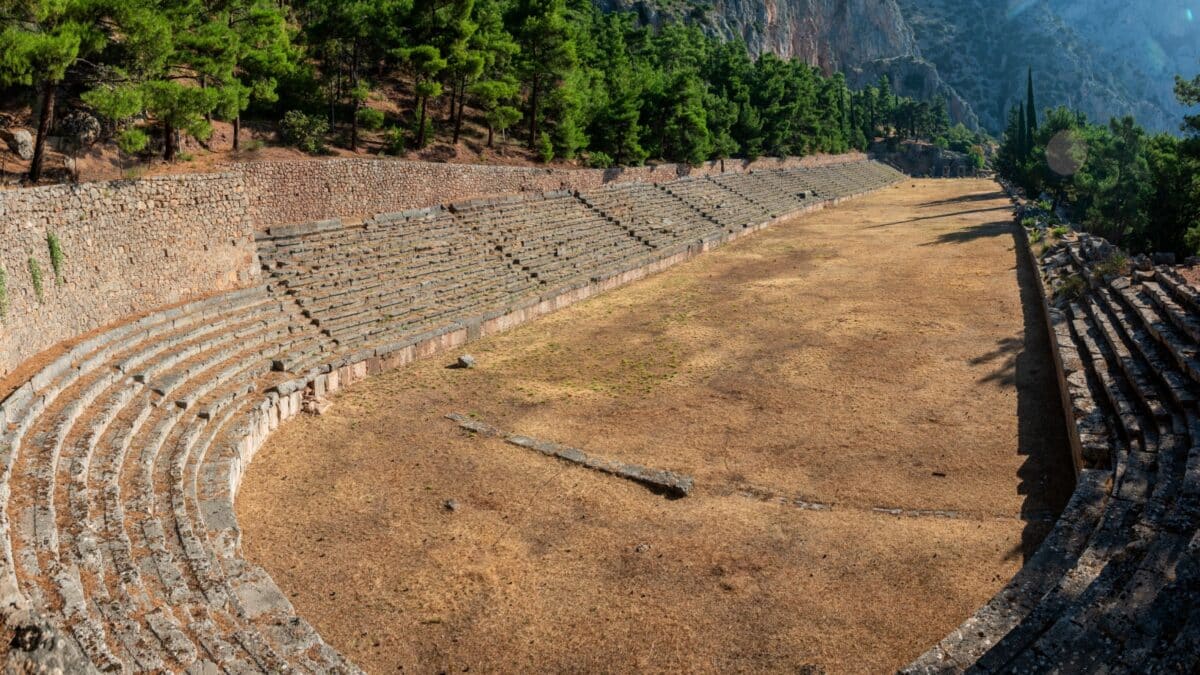
Photo credit: Karl Allen Lugmayer / Shutterstock.com
5.) The Stadium: Further up the hillside, you’ll find the well-preserved remains of the Delphi stadium. Here, the ancient Pythian Games were held every four years, second only in importance to the Olympic Games. Unfortunately, the stadium can sometimes be closed due to wind, which was the case on the day we visited.
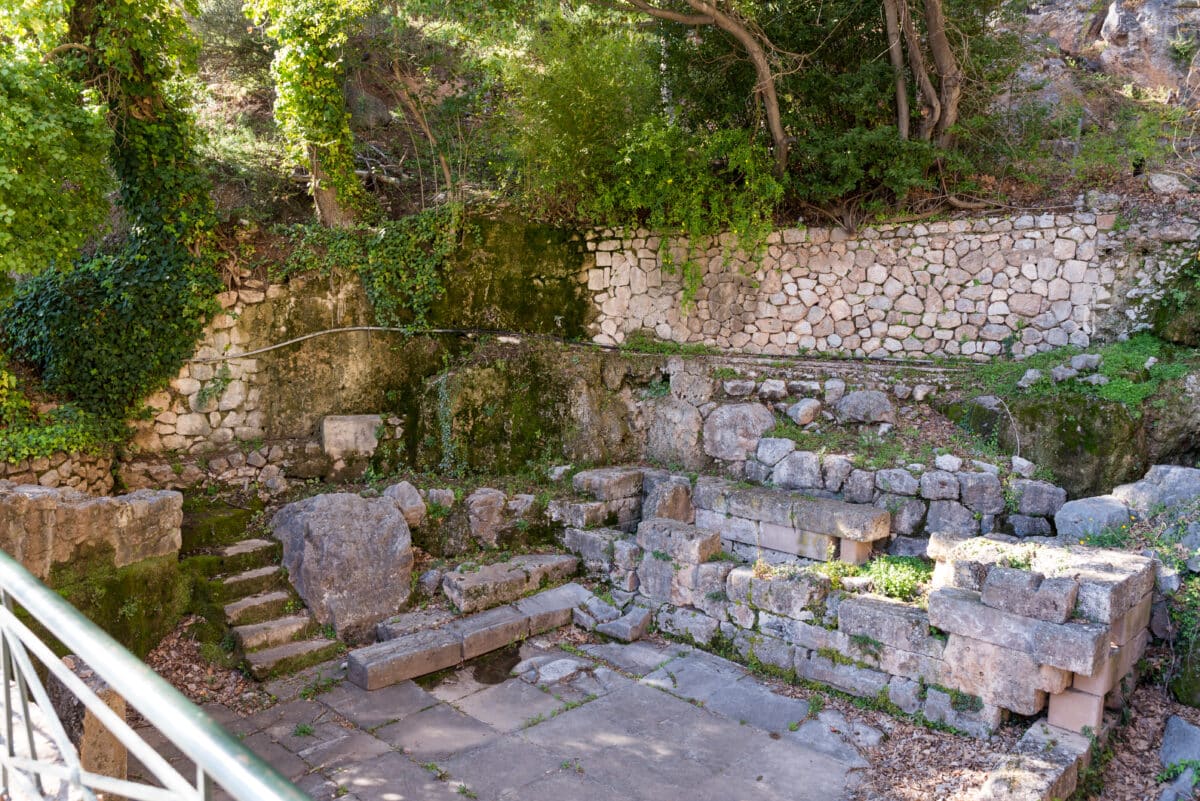
6.) The Castalian Spring: This natural spring, dedicated to the Muses, was believed to have inspirational and purifying powers. Pilgrims would cleanse themselves in the waters before ascending to the Oracle. It’s located near the museum and can be easy to miss, especially because the spring is relatively dry now!
History of Delphi’s Ancient Ruins: The Temple of Apollo and the Oracle

The Temple of Apollo is the most iconic and significant structure on the site. This majestic temple was the spiritual and political center of the ancient Greek world, serving as the home of the legendary Oracle of Delphi.
The Oracle, a high priestess of the god Apollo, would sit on a tripod over a chasm in the temple, inhaling intoxicating vapors that were believed to induce a trance-like state. In this altered state, the Oracle would then provide prophecies and advice to those who came seeking wisdom and guidance from the gods.

The process of consulting the Oracle was a deeply revered and ritually complex affair. Pilgrims would make the long journey to Delphi, bringing valuable offerings and gifts, and would carefully follow the prescribed protocols to make a successful audience with the Oracle. The pronouncements of the Oracle were then interpreted by the priests of the temple, who would convey the divine message to the people.
The Temple of Apollo and the Oracle of Delphi played crucial roles in the political, social, and religious life of the ancient Greek world. Kings, generals, and ordinary citizens sought the wisdom and foresight of the gods through the Oracle’s prophecies. The ruins of this sacred site, with their haunting beauty and enduring mystery, continue to captivate visitors from around the world.
Delphi Museum
A visit to the remarkable Delphi Archaeological Museum is also an absolute must. It houses an impressive collection of artifacts and treasures from Delphi.
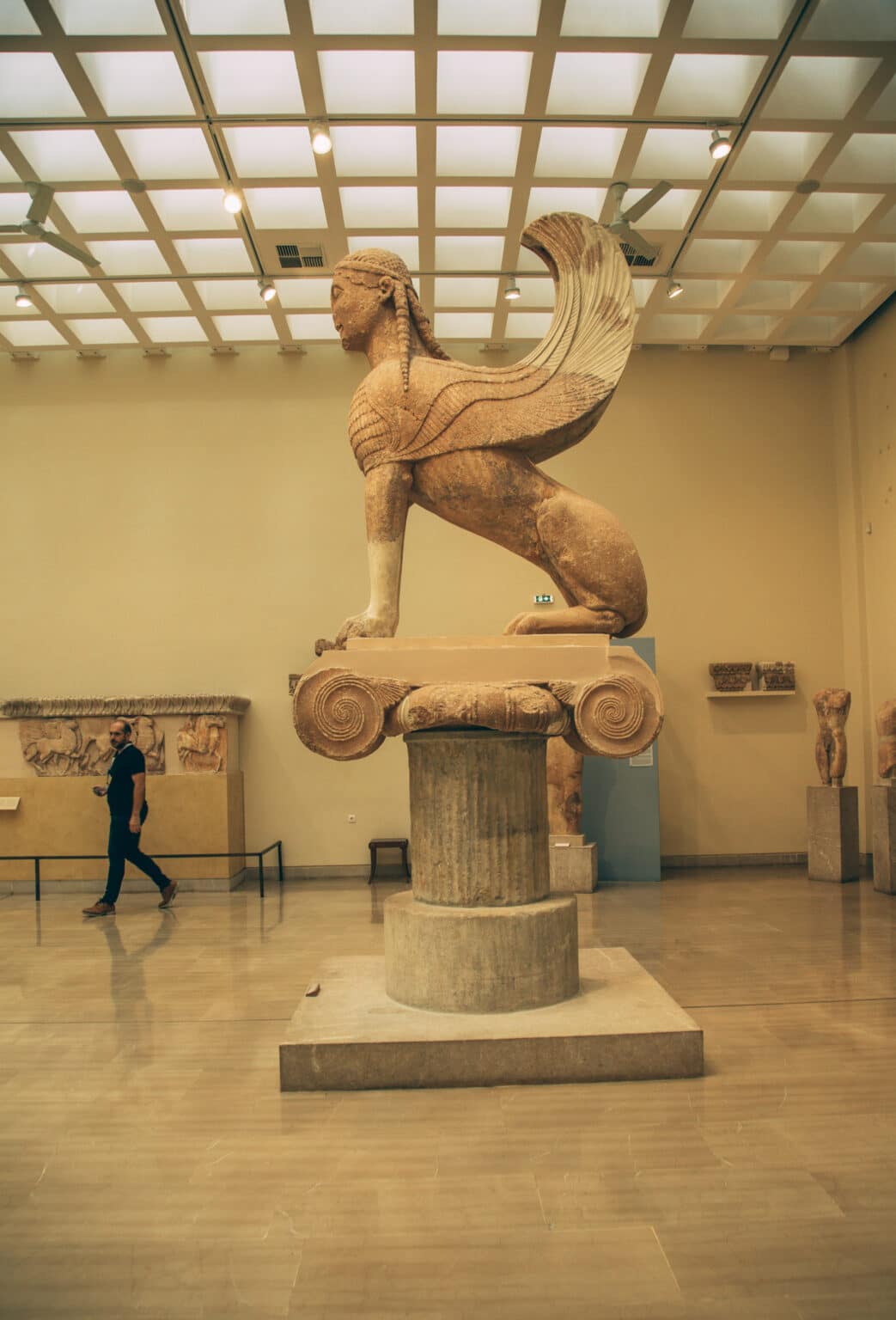
The museum’s galleries are meticulously curated and showcase a diverse array of ancient Greek art, including incredible sculptures, intricate bronze statues, stunning marble reliefs, and a wealth of other archaeological finds.
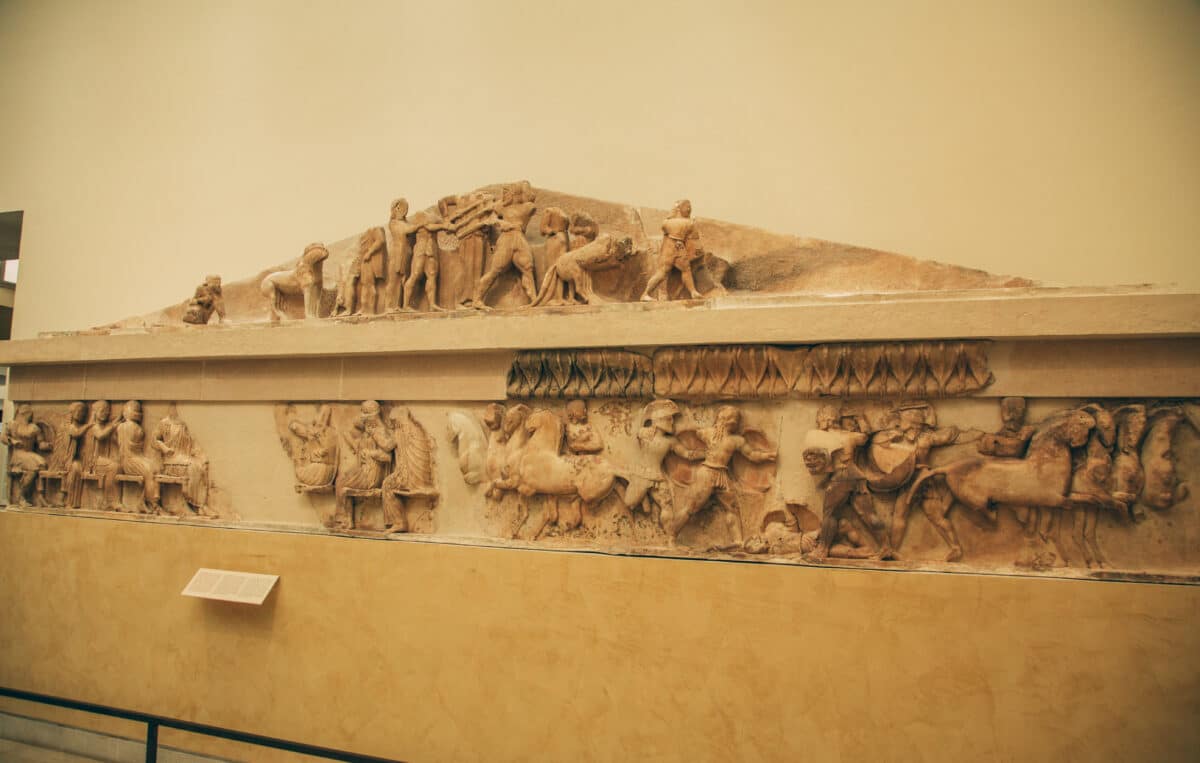
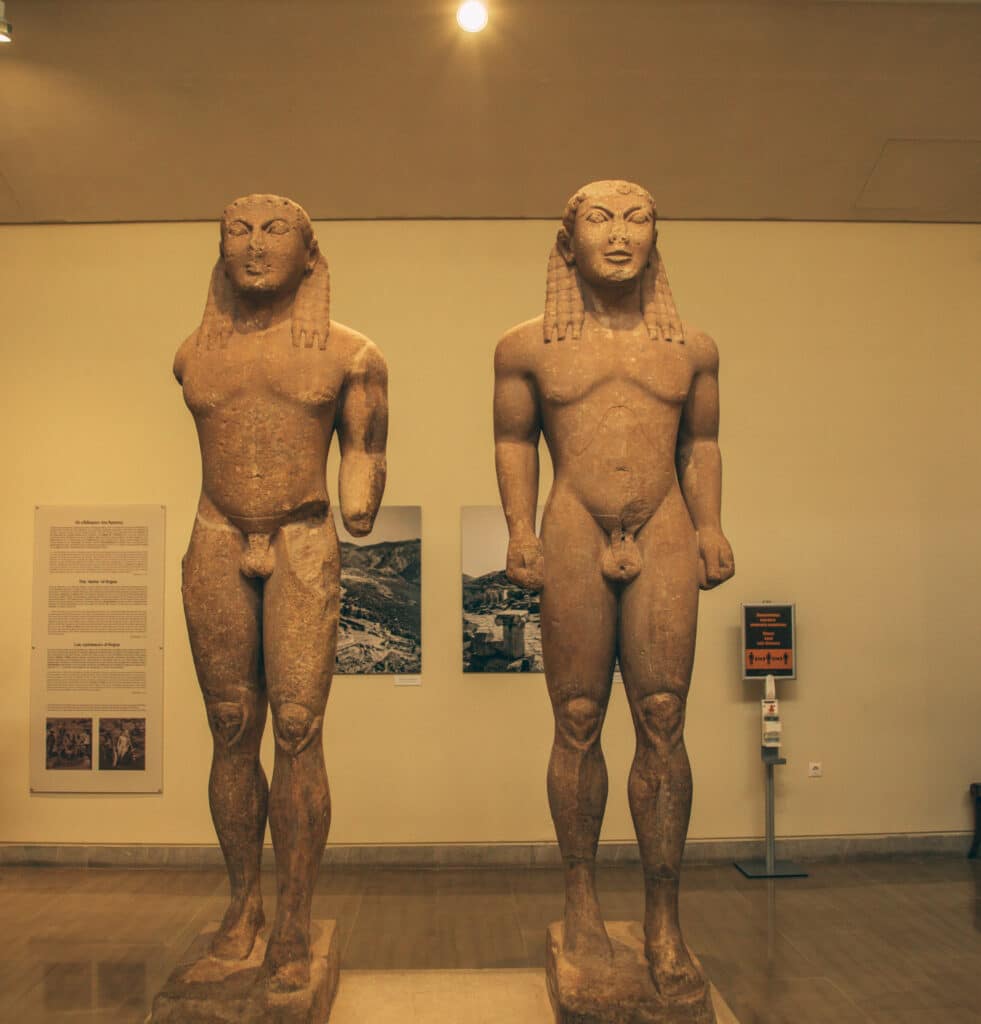
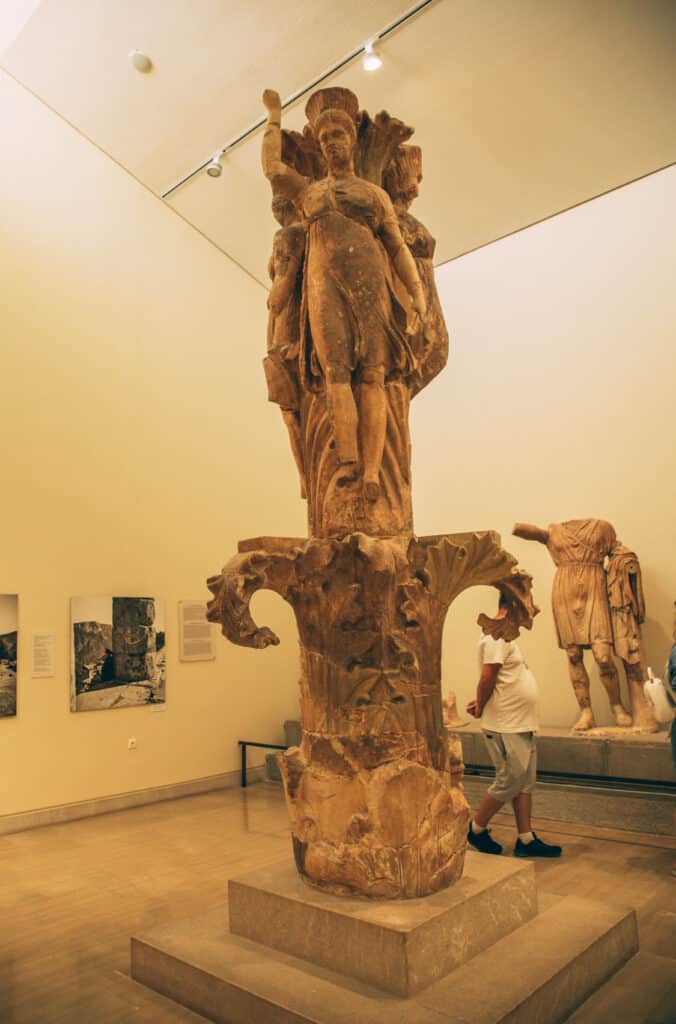

Another great aspect of the Delphi Museum is that it is air-conditioned. Walking through the ruins can be incredibly hot, even if you visit in the fall, as I did!
There are also quite a few friendly and adorable cats that call Delphi home, and like to hang out near the museum entrance, this is something to keep in mind if you are allergic.
It took us about 3 hours to see all of these things, and we were walking at a relatively leasurily pace and taking photos.

Tips for Visiting Delphi
1.) Best time to visit Delphi
You can visit Delphi at any time during the year. However, the milder temperatures and fewer crowds of late spring, which is March-May, and autumn, September-November, offer more pleasant conditions.
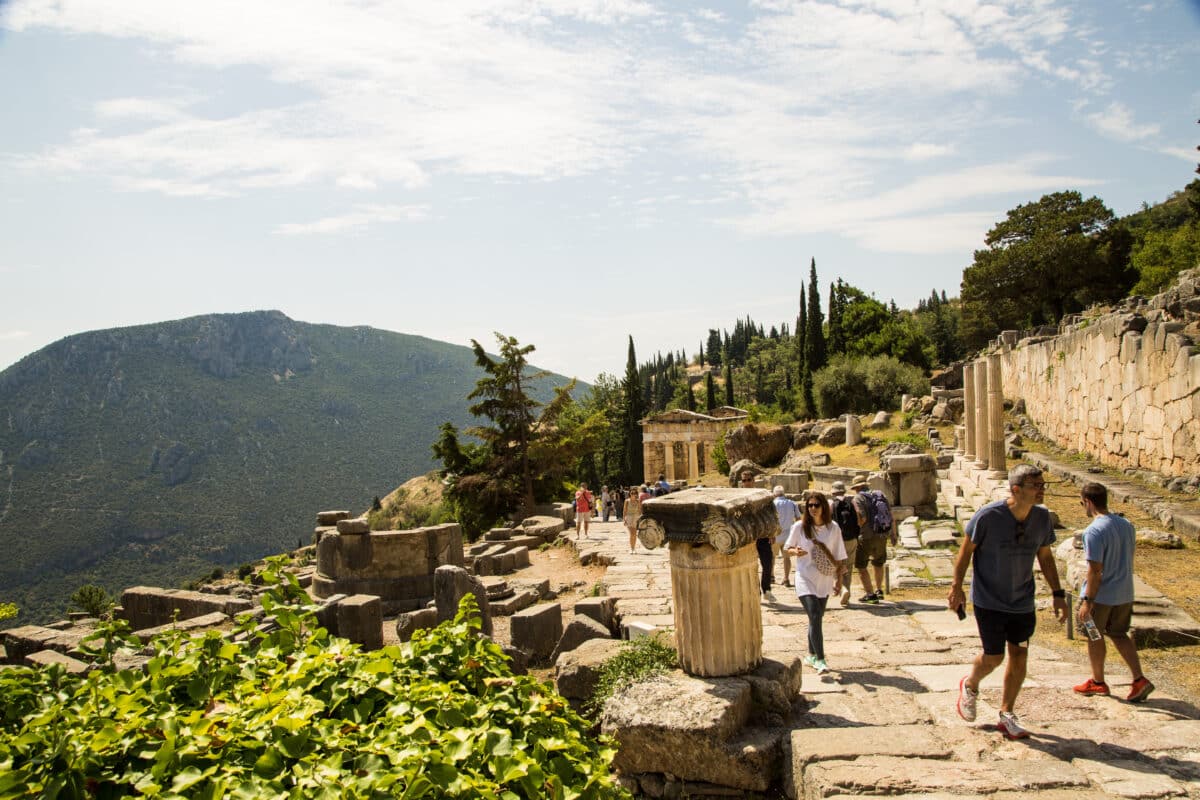
Summer provides warmer and dryer weather, of course, but it is also absolutely crazy in terms of tourism, as is the case throughout Greece during the summer months.
I personally visited Delphi during September, and there were plenty of people there, but it didn’t feel too overwhelming. I can’t imagine how much crazier it would be during the peak season!
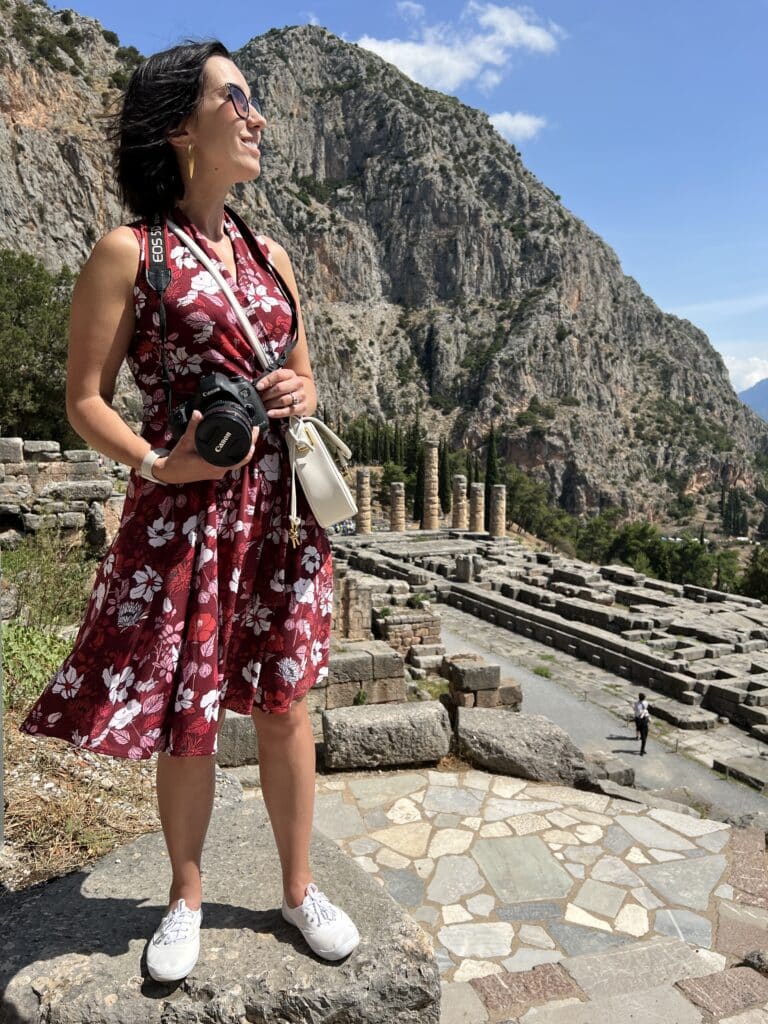
2.) Wear Comfortable Shoes and dress comfortably: There is a lot of walking at Delphi, you are going to want to wear your most comfortable shoes for this day. CLosed toe shoes are also a good idea. And While is some sites, like Meteora, there is a dress code. There is no dress code at Delphi, feel free to wear whatever you are most comfortable in, just keep in mind that it can be quite warm even in fall and spring, so wear breathable clothing.
3.) Bring Sun Protection: It can be quite sunny and hot here, so be sure to pack sunscreen and sunglasses.
4.) Stay Hydrated: Carrying a water bottle at all times is a must, as you’ll want to stay hydrated while exploring Delphi. The cafe near the museum sells water and snacks; however, there won’t be anything once you are inside the ruins, so be sure to pack plenty of water!
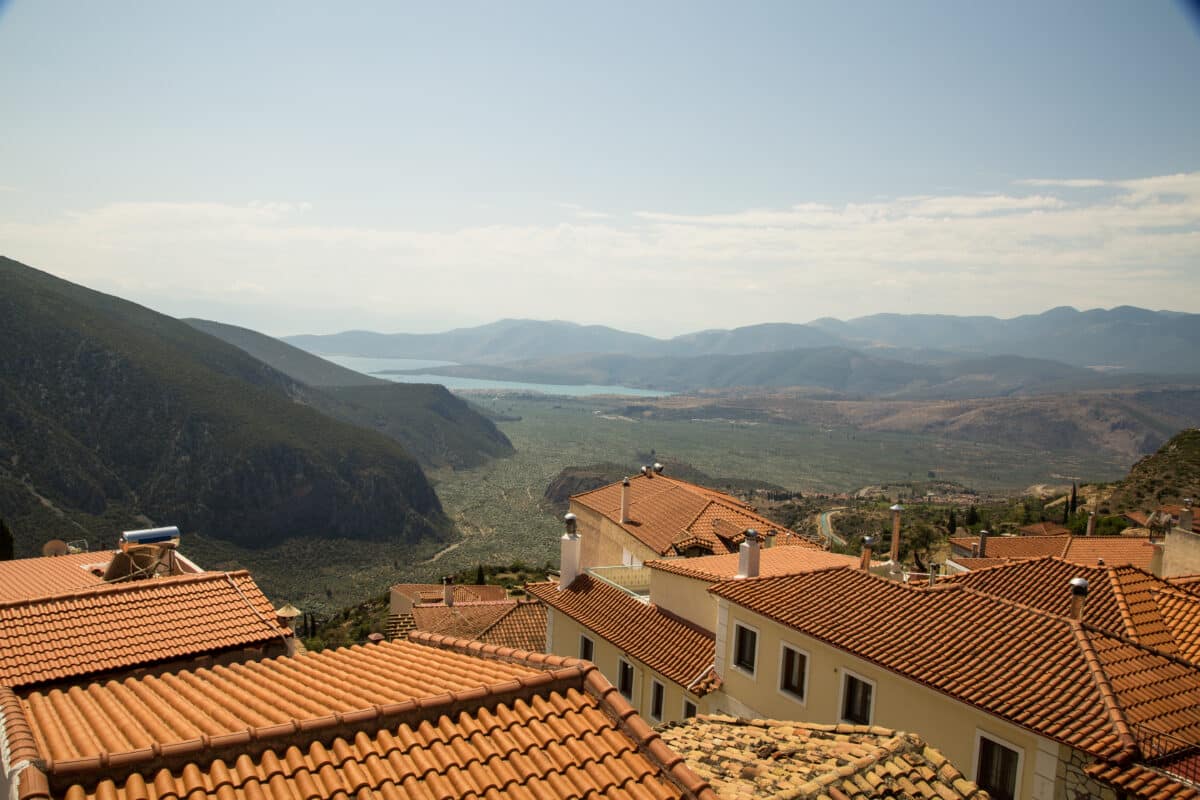
5.) Save time for lunch or dinner in one of the traditional tavernas in the town of Delphi. I personally dined at Taverna Vakhos and had a wonderful experience. Be sure to save room for some hearty food!
So, Is Delphi Worth Visiting?
I am personally very glad that I visited Delphi, and do recommend it if your schedule allows. However, I do want to mention if I had to choose between visiting Delphi or visiting Meteora… I personally found Meteora to be more awe-inspiring than Delphi. Meteora’s landscapes and monasteries are unlike anything I have ever seen, and it’s one of the most incredible places I have ever visited.

That said, if you are a history buff, Delphi arguably holds far more historical significance than Meteora. You will be much more impressed with Delphi. And again, it’s much easier to do a day trip to Delphi from Athens than it is to visit Meteora in 1 day.
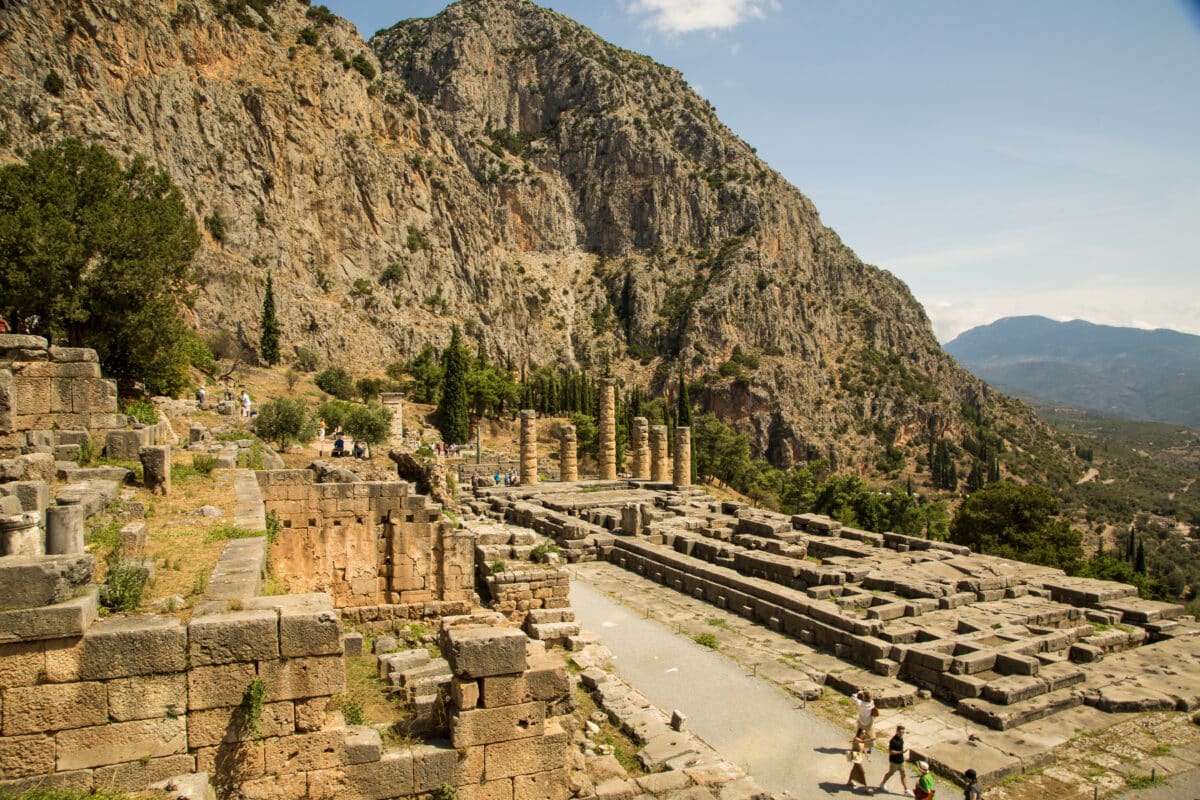
Delphi truly transports you to a bygone era, where the line between the mortal and divine was blurred, and the wisdom of the gods was sought by kings and commoners alike. Whether you’re a history buff, a nature lover, or simply looking for a unique cultural experience, Delphi does have something to offer everyone.
- Read next: Meteora, Greece Travel Guide: Exploring the Surreal Monasteries
- Read next: 3 Days in Santorini: A Laid-Back Santorini Itinerary for First-Time Visitors
- Read next: My Honest IKIES Santorini Review – The Best Hotel in Santorini?
If anyone has any questions about visiting Delphi, Greece, don’t hesitate to reach out in the comments!

